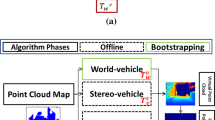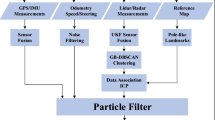Abstract
Self-driving systems require the creation of perception, which means that they must learn to interact with their environment, gather information and perform tasks while driving. Localization and mapping are essential concepts that any autonomous vehicle must perceive, as they provide information about the location and distance between objects. The absence of GPS, for example, in tunnels and urban canyons, makes it necessary to develop robust methods based on other vehicle equipment, such as Lidar, cameras, IMU, or to combine them all. Based on Lidar measurements, our work presents an architecture consisting of two main phases of mapping and localization; The mapping phase creates a global map of the environment based on non-semantic features using a fuzzy c-means algorithm instead of a semantic algorithm as it was done in some state-of-the-art work. In addition, the remaining clusters were filtered using the DBSCAN algorithm. The localization phase adopted here followed the particle filter architecture; motion update, measurement update, and resampling to estimate the positions. The main contribution of this work is the novel extension of selecting particles to reduce computational time and maintain long-term localization reliability. We have exhibited a method to select relevant particles after motion updates, based on two approaches: clustering with the k-means algorithm and the sigma points algorithm, which were thoroughly examined on short sequences of the Kitti dataset to discover the best one. The selected approach thoroughly tested on the Pandaset dataset. In addition, we tested our method on a long sequence dataset and compared it with the most recent methods. The analysis performed demonstrated the speed of our method and its ability to capture the features needed for real-time localization. Furthermore, it outperformed the well-known localization methods.





Similar content being viewed by others
Data availability statement
The datasets generated during and analysed during the current study are available in the Kitti repository and Pandaset repository: http://www.cvlibs.net/datasets/kitti/, https://pandaset.org/
References
Biber P (2003) The normal distributions transform: a new approach to laser scan matching. IEEE Int Conf Int ll Robot Syst 3:2743–2748. https://doi.org/10.1109/iros.2003.1249285
Biber P (2003) The normal distributions transform: a new approach to laser scan matching. IEEE Int Conf Int ll Robot Syst 3:2743–2748. https://doi.org/10.1109/iros.2003.1249285
Charroud A, Yahyaouy A, El Moutaouakil K, Onyekpe U (2022) Localisation and mapping of self-driving vehicles based on fuzzy K-Means clustering: a Non-Semantic approach 2022 international conference on intelligent systems and computer vision (ISCV), https://doi.org/10.1109/iscv54655.2022.9806102
Daszykowski M, Walczak B (2009) Density-Based Clustering methods. Compr Chemom 2:635–654. https://doi.org/10.1016/B978-044452701-1.00067-3
Dawen X, Zhang M, Yan X, Bai Y, Zheng Y, Li Y, Li H (2020) A distributed WND-LSTM model on mapreduce for Short-Term traffic flow prediction. Neural Comput Applic 33(7):2393–2410. https://doi.org/10.1007/s00521-020-05076-2
Du S, Xu Y, Wan T, Hu H, Zhang S, Xu G, Zhang X (2017) Robust iterative closest point algorithm based on global reference point for rotation invariant registration. PLoS One 12:1–14. https://doi.org/10.1371/journal.pone.0188039
Gálvez-López D, Tardós JD (2012) Bags of binary words for fast place recognition in image sequences. IEEE Trans Robot 28:1188–1197. https://doi.org/10.1109/TRO.2012.2197158
Geiger A, Lenz P, Stiller C, Urtasun R (2013) Vision meets robotics: the KITTI dataset. Int J Robotics Res Int J Rob Res, pp 1–6
HKUST-Aerial-Robotics (2022) HKUST-Aerial-Robotics/A-LOAM: advanced implementation of loam. Github, Accessed 8 August, https://github.com/HKUST-Aerial-Robotics/A-LOAM
Huang X, Mei G, Zhang J, Abbas R (2021) A comprehensive survey on point cloud registration, pp 1–17
Huang X, Zhang J, Wu Q, Fan L, Yuan C (2018) A coarse-to-fine algorithm for matching and registration in 3d cross-source point clouds. IEEE Trans Circuits Syst Video Technol 28:2965–2977. https://doi.org/10.1109/TCSVT.2017.2730232
Julier SJ (1997) Uhlmann, Jeffrey A New Extension of the Kalman Filter to Nonlinear Systems. Proc. SPIE 3068, signal processing, sensor fusion, and target recognition VI, 182 (28 July 1997)
Karaim M, Elsheikh M, Noureldin A (2018) GNSS Error sources. Multifunct Oper Appl GPS. https://doi.org/10.5772/intechopen.75493
Kim D, Chung T, Yi K (2015) Lane map building and localization for automated driving using 2D laser rangefinder. 2015 IEEE Intell Veh Symp, pp 680–685. https://doi.org/10.1109/IVS.2015.7225763
Kummerle J, Sons M, Poggenhans F, Kuhner T, Lauer M, Stiller C (2019) Accurate and efficient self-localization on roads using basic geometric primitives. Proc - IEEE Int Conf Robot Autom 2019-May, pp 5965–5971, https://doi.org/10.1109/ICRA.2019.8793497
Künsch HR (2013) Particle filters. Bernoulli, pp 19, https://doi.org/10.3150/12-BEJSP07
Kuutti S, Fallah S, Katsaros K, Dianati M, Mccullough F, Mouzakitis A (2018) A survey of the state-of-the-art localization techniques and their potentials for autonomous vehicle applications. IEEE Internet Things J 5:829–846. https://doi.org/10.1109/JIOT.2018.2812300
Laboshinl (2022) Laboshinl/loam_velodyne. GitHub. Accessed 8, August. https://github.com/laboshinl/loam_velodyne
Levinson J, Montemerlo M, Thrun S (2007) Map-based precision vehicle localization in urban environments. Robotics: Sci Syst III, https://doi.org/10.15607/rss.2007.iii.016
Li Q, Chen S, Wang C, Li X, Wen C, Cheng M (2019) LO-Net: deep realtime Lidar odometry. In: Proc IEEE Conf Comput Vis Pattern Recognit, pp 8473–8482
Liu Z, Zhang F (2021) BALM: bundle adjustment for lidar mapping. IEEE Robot Autom Lett 6:3184–3191. https://doi.org/10.1109/LRA.2021.3062815
Lu W, Wan G, Zhou Y, Fu X, Yuan P, Song S (2019) DeepICP: an end-to-end deep neural network for point cloud registration. Proc IEEE Int Conf Comput Vis 2019-Octob, pp 12–21. https://doi.org/10.1109/ICCV.2019.00010
Moireau P, Dominique C (2010) Reduced-order unscented kalman filtering with application to parameter identification in large-dimensional systems. ESAIM Cont, Optimisation Calculus of Variations 17(2):380–405. https://doi.org/10.1051/cocv/2010006
Montiel JMM, Mur-Arta R, Tardos JD (2015) ORB-SLAM: a versatile and accurate monocular. IEEE Trans Robot 31:1147–1163
Mur-Artal R, Tardos JD (2017) ORB-SLAM2: an open-source SLAM system for monocular, stereo, and RGB-D cameras. IEEE Trans Robot 33:1255–1262. https://doi.org/10.1109/TRO.2017.2705103
Nadav DYM, Maron H, Lipman Y (2017) DS++: a flexible, scalable and provably tight relaxation for matching problems. ACM Trans Graph, pp 36. https://doi.org/10.1145/3130800.3130826
Nerem RS, Larson KM (2001) Global positioning system, theory and practice 5th edition. https://doi.org/10.1029/01eo00224
Onyekpe U, Palade V, Herath A, Kanarachos S, Fitzpatrick ME (2021) WhONet: wheel odometry neural network for vehicular localisation in GNSS-deprived environments. Eng Appl Artif Intell, pp 105. https://doi.org/10.1016/j.engappai.2021.104421
Schaefer A, Büscher D., Vertens J, Luft L, Burgard W (2021) Long-term vehicle localization in urban environments based on pole landmarks extracted from 3-D lidar scans. Rob Auton Syst 136:103709. https://doi.org/10.1016/j.robot.2020.103709
Sefati M, Daum M, Sondermann B, Kreiskother KD, Kampker A (2017) Improving vehicle localization using semantic and pole-like landmarks. IEEE Intell Veh Symp Proc, pp 13–19, https://doi.org/10.1109/IVS.2017.7995692
Shan T, Brendan E (2018) Lego-loam, : lightweight and ground-optimized lidar odometry and mapping on variable terrain 2018 IEEE/RSJ international conference on intelligent robots and systems (IROS), https://doi.org/10.1109/iros.2018.8594299
Shuang L, Cao Z, Wang C, Yu J, Wang S (2021) A novel sparse geometric 3-d lidar odometry approach. IEEE Syst J 15(1):1390–1400. https://doi.org/10.1109/jsyst.2020.2995727
Sjafrie H (2013) Introduction to self-driving vehicle technology. Bernoulli 19:1391–1403. https://doi.org/10.3150/12-BEJSP07
Sjafrie H (2019) Introduction to self-driving vehicle technology (1st edn.) Chapman and hall/CRC. https://doi.org/10.1201/9780429316777
Team CARLA (2022) Carla CARLA simulator. 9 Accessed August, https://carla.org/
Thrun S (2002) Probabilistic robotics. Commun ACM 45:52–57. https://doi.org/10.1145/504729.504754
Van Der Merwe R, Wan R (2004) Sigma point Kalman filters for probabilistic inference in dynamic state-space models. PhD thesis, OGI school of science & engineering, oregon health & science university USA
Wael F (2021) Real-Time Autonomous vehicle localization based on particle and unscented kalman filters. J Cont, Autom Electric Syst 32(2):309–25. https://doi.org/10.1007/s40313-020-00666-w
Weng L, Yang M, Guo L, Wang B, Wang C (2019) Pole-based real-time localization for autonomous driving in congested urban scenarios. 2018. IEEE Int Conf Real-Time Comput Robot RCAR 2018:96–101. https://doi.org/10.1109/RCAR.2018.8621688
Xiao P, Shao Z, Hao S, Zhang Z, Chai X, Jiao J, Li Z, Wu J, Sun K, Jiang K, Wang Y, Yang D (2021) Pandaset: advanced sensor suite dataset for autonomous driving. IEEE Conf Intell Transp Syst Proc, ITSC. 2021-September, pp 3095–3101, https://doi.org/10.1109/ITSC48978.2021.9565009
Yuan W, Eckart B, Kim K, Jampani V, Fox D, Kautz J (2020) DeepGMR: learning latent gaussian mixture models for registration. Lect Notes Comput Sci (including Subser Lect Notes Artif Intell Lect Notes Bioinformatics), 12350 LNCS, pp 733–750. https://doi.org/10.1007/978-3-030-58558-7_43.
Yurtsever E, Lambert J, Carballo A, Takeda K (2020) A survey of autonomous driving: common practices and emerging technologies. IEEE Access 8:58443–58469. https://doi.org/10.1109/ACCESS.2020.2983149
Zhang J, Singh S (2017) Low-drift and real-time lidar odometry and mapping. Auton Robots 41:401–416. https://doi.org/10.1007/s10514-016-9548-2
Acknowledgements
The authors thank all those who contributed to this article.
Author information
Authors and Affiliations
Corresponding author
Ethics declarations
Conflict of interests and Funding
All authors certify that they have no affiliation or involvement with any organization or entity with financial or non-financial interests in the subject matter or material covered by this manuscript.
Additional information
Publisher’s note
Springer Nature remains neutral with regard to jurisdictional claims in published maps and institutional affiliations.
Rights and permissions
Springer Nature or its licensor (e.g. a society or other partner) holds exclusive rights to this article under a publishing agreement with the author(s) or other rightsholder(s); author self-archiving of the accepted manuscript version of this article is solely governed by the terms of such publishing agreement and applicable law.
About this article
Cite this article
Charroud, A., Moutaouakil, K.E. & Yahyaouy, A. Fast and accurate localization and mapping method for self-driving vehicles based on a modified clustering particle filter. Multimed Tools Appl 82, 18435–18457 (2023). https://doi.org/10.1007/s11042-022-14111-4
Received:
Revised:
Accepted:
Published:
Issue Date:
DOI: https://doi.org/10.1007/s11042-022-14111-4




